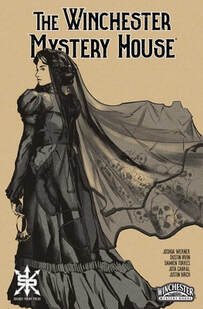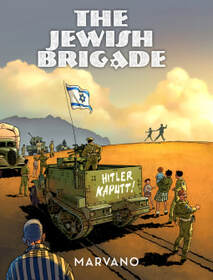
Vol 1: Kill Columbus, illustrated by Davide Gianfelice, colored by Joana LaFuente
In the year 2112, the Earth has been destroyed by wars, pollution, and more. Portions of the population have already taken to the skies in search of a new planet. But in the desert of Arizona, a group of Native Americans find a cave that sends them back in time. They hatch a plan to save the world and protect their ancestors, but it involves killing Christopher Columbus before he discovers America. The group chooses Tad, who is a linguist and could potentially pass as sailor, to jump back and try to find a way onto Columbus' ship, but this means leaving behind his family in the future and relying on his knowledge of history to help him navigate through the voyage of Columbus.
0 Comments

Illustrated by Dustin Irvin and Damien Torres
Widow Sarah Winchester moves to California and begins work on a sprawling mansion where construction must never cease. She assembles a team of laborers who work around the clock to keep building new wings of the house. Despite the enormous labor force, her project is plagued with setbacks. Robber barons try to take part Sarah's land for the construction of the railroad, but Sarah and her niece sabotage the survey equipment night after night. Other members of the California wealthy want in on Sarah's inner circle, and sabotage her when they are rebuked. A member of her crew accidentally stabs a co-worker and swears it was because of tricks played on him by vengeful spirits. And then there is the question about the spirits themselves and the role they played in the building of the Winchester Mystery House. 
Based on and adapted from the screenplay by Brandon Beckner and Scott Sampila
In San Francisco in 1971, Reporter Seymour Phillips stumbles upon some clues that a recent drug bust might not be all it seems. After an ill-fated trip to talk to the suspect in prison, Seymour’s life gets destroyed by a planted bag of marijuana that sends him to jail. He loses him his job and his girlfriend. A few years later, he meets Chase, a drug addict, potentially with some mental illnesses, who claims to have been part of a super top-secret CIA operation to develop compound LSD-25 into a tool for interrogation and mind control. Chase leads Seymour on a crazy ride that includes taking drugs, disguises, clandestine meetings, amongst other things, as they uncover an operation that included prostitutes and experimenting on Johns and the operatives themselves. 
History Comics: The National Parks: Preserving America's Wild Places
Follow Bigfoot and Eagle through an historical look at the founding of America's National Parks. Bigfoot embodies the spirit of National Parks and explains to Eagle, the embodiment of the American People, how they all came to be. We start off with Yosemite and Yellowstone, and take a look at what acts of Congress and presidential actions made pieces of the country into National Parks. We also take a look at the founding of Park Rangers, and what their role was in preserving the parks from human disruption. As the idea of parks changed, activists were able to argue that land of historical significance, not just natural beauty, could become a National Park, as is the case with Mesa Verde National Park. 
Illustrated by Nate Powell
The final book in this trilogy picks up with events early in 1963 when a church in Birmingham was bombed, and four young girls were killed. John Lewis and SNCC (Student Nonviolent Coordinating Committee) and other Civil Rights groups came together after that bombing to try to get more representation on a state and national level since their local politicians were going to continue to turn a blind eye to violence. They organized into the Freedom Democratic Party and tried to take part in the Democratic National Convention, but drew the ire of LBJ in his re-election campaign. Larger demonstrations were necessary as violence mounted and became more blatant. Lewis and his fellows conceived of a march from Selma, Alabama, to the capital in Montgomery, an event that is now referred to as "Bloody Sunday" because of how badly law enforcement officers beat demonstrators. After that terrible day, another march was planned with Lewis and Martin Luther King, Jr., and this time, they were successful in reaching Montgomery. The finale ties together Lewis and Aydin discussing commemorating all the important work of Lewis' life into a comicbook. 
When the German forces surrendered at the end of World War II, a select unit of Jewish Soldiers, British and Palestinian, became an unofficial unit known as The Jewish Brigade. These soldiers made detours during their official missions in order to hunt down elite Nazis or save any Jewish survivors of the Concentration Camps. This story focuses on Leslie Toliver. Toliver and his Palestinian friend, Ari, rescue a girl named Safaya from a church where a former SS official was acting as a priest. Ari and another British officer covertly rescue truckloads of Jewish civilians from the Russian city of Graz before it comes under British control because they feared Anti-Semitism that would make like difficult or impossible for those survivors. The Jewish civilians are trying to make their way to Palestine, where the U.N. had a planned Jewist State. Later, Toliver supports the Jewish forces in Palestine fighting for their own state. He and Safaya are reunited, but now, Safaya is a soldier fighting for her people against the Arabs in Palestine who oppose the partition of their country.

In this blend of historical and scientific perspective, Fetter-Vorm explores the race between several countries to create the Atom Bomb, starting with the theoretical exploration of splitting atoms, to the realization of the theory under the Manhattan Project. Fetter-Vorm particularly focuses on the American efforts, so there is little detail from other countries involved in the race. The beginning of the novel focuses heavily on the science behind how it's possible to split an atom and what happens on a molecular level. The historical perspective is sprinkled throughout this section, but really becomes the major focus during the second half of the book. Particular attention is given to Oppenheimer and General Leslie Groves as the leaders of the project. Fetter-Vorm also goes into quite a bit of detail about the dropping of Little Boy, the Uranium atom bomb, and Fat Man, the plutonium atom bomb, on Hiroshima and Nagasaki, respectively, and how each of the different types of atomic bombs' explosions affected the cities and people.

Kleist presents the true story of champion boxer, Emile Griffith.
One day while at work, in a most oppressive heat, Emile Griffith was stuffing hats in boxes, singing to himself, when several people noticed that his physique was that of a boxer. His boss, Mr. Arnold, took Emile to a local boxing gym and got him set up with a trainer and his first match. Even though Emile didn't want to hurt anyone, he found he was really good at boxing. His strategy? Hit the other guy before he has a chance to hit you. Emile would go on to win many championships and start his own line of Ladies Hats with his former shop. Emile also took several lovers along the way, but, despite their encouragement, he never wanted to get into activism or anything outside of the ring that would draw attention to his personal life. His major rival was Benny "Kid" Paret, who hurled a homophobic slur at Griffith before one of the title matches. Paret later died from his injuries sustained by Griffith during the match. 
Illustrated by Nate Powell
In this second volume of the life of former Senator John Lewis, we see Lewis as a college student who is getting more and more involved in the racial protests in the South. Lewis was one of the first and longest members of the Freedom Riders group who bought tickets on buses going between several states and challenged bus company's rules that buses needed to be segregated. This was in direct violation of the Supreme Court ruling in Morgan v. Virginia where the court found segregated buses to be unconstitutional. Lewis narrowly missed being on one of the buses that was attacked and torched by KKK members. On several occasions, Lewis and other riders were jailed and refused to post bail, saying that paying it would then fund the racist policies they were fighting against. Lewis gets more involved with Dr. King, and is selected as one of the six representatives to meet with President Kennedy on the racial tensions in the south. Lewis is elected the president of SYNC, and later is the last speaker at the March on Washington for Jobs and Freedom where King delivered his famous, "I Have a Dream Speech." Included in end notes is the full text of Lewis' speech, called "This is It". 
Illustrated by David Namisato
Sandy is a young noy growing up in British Columbia who loves baseball. It’s one of the things he and his father enjoy together, that is when is father isn’t off providing medical treatments to folks. Sandy’s family and of Japanese decent, and they live in a thriving Japanese community in BC, who all root for the Asahi, the local baseball team who just lost the championship, but are hopeful to get it back next season. Then, the Japanese bomb Pearl Harbor, and things start getting more complicated for Sandy and his family. They have to give up some of their possessions “for safekeeping”, knowing full well they will be sold off; they have to be in their homes by sundown, which makes the father’s job much harder; and there are certain areas of port cities they are no longer allowed to live in. Soon enough, the families are transported to camps that have been set up at abandoned mining facilities. |
About MeI've been reading manga and comicbooks for years. Now, I write reviews and other helpful things for School Librarians, teachers, parents, and students. Search this siteRatings, Audience, and Subject Tags
All
Archives
July 2024
|




